Roe v. Wade Worksheets
Do you want to save dozens of hours in time? Get your evenings and weekends back? Be able to teach about Roe v. Wade to your students?
Our worksheet bundle includes a fact file and printable worksheets and student activities. Perfect for both the classroom and homeschooling!
Resource Examples
Click any of the example images below to view a larger version.
Fact File
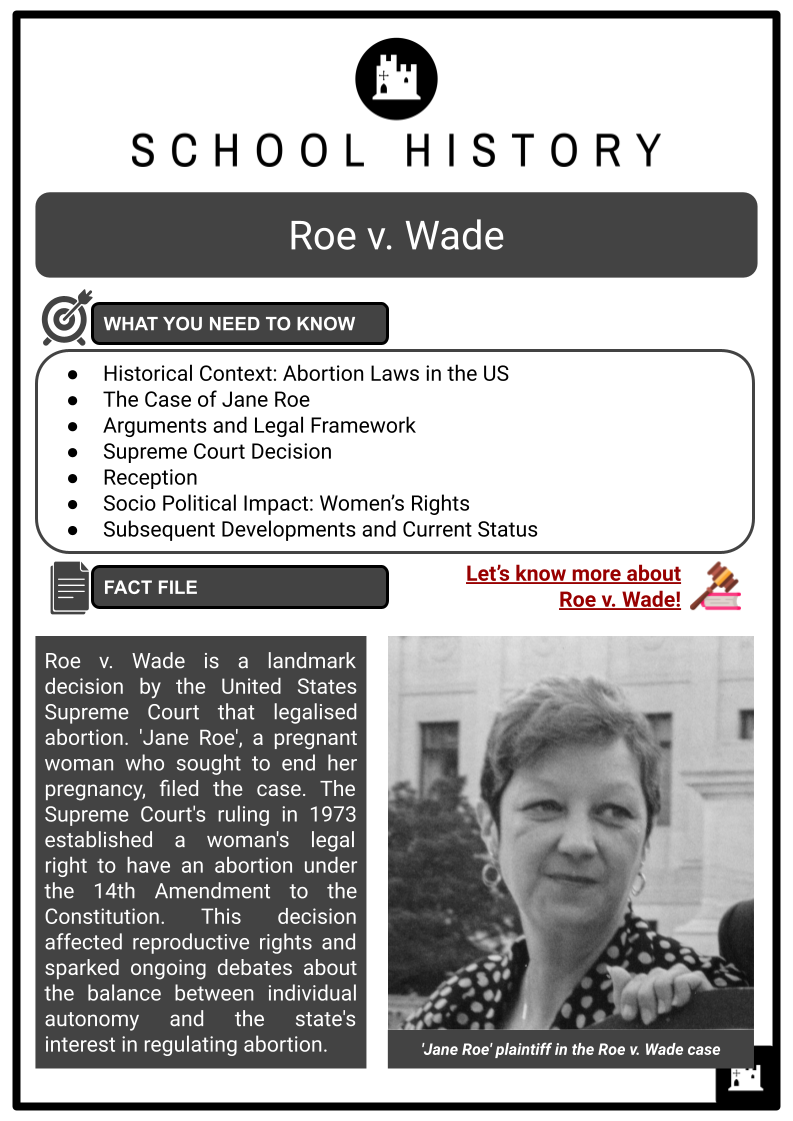
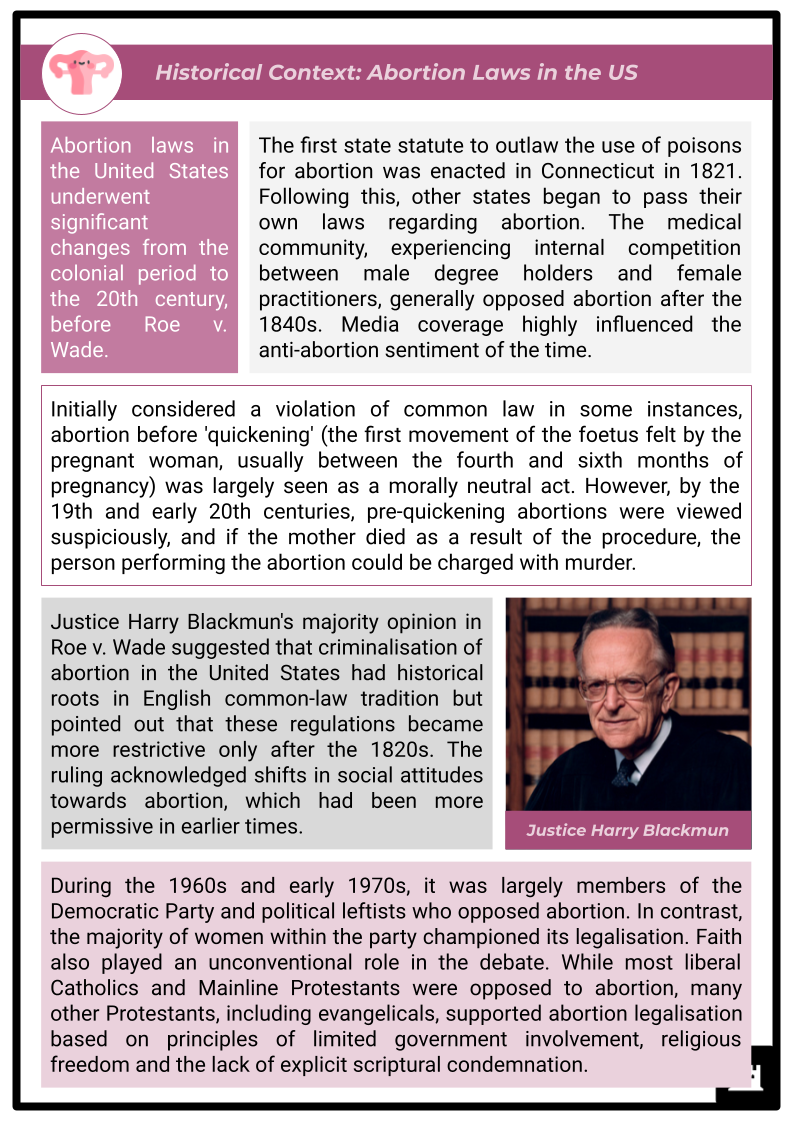
Student Activities
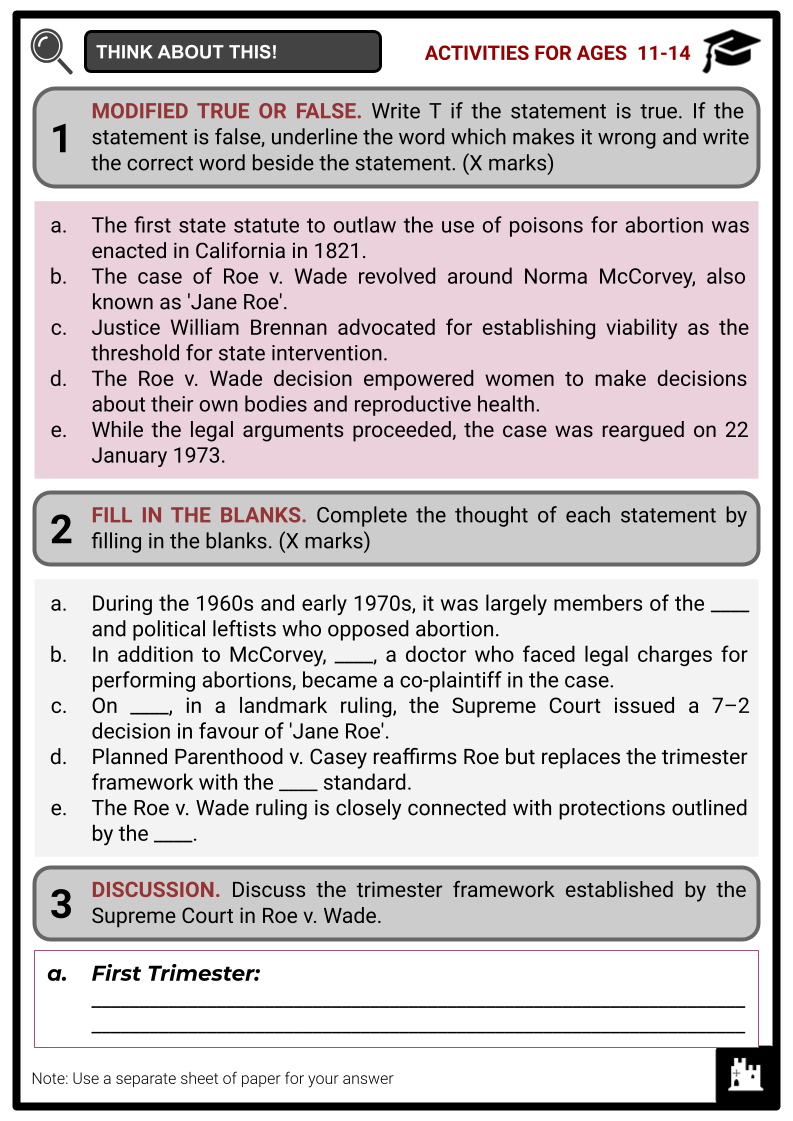
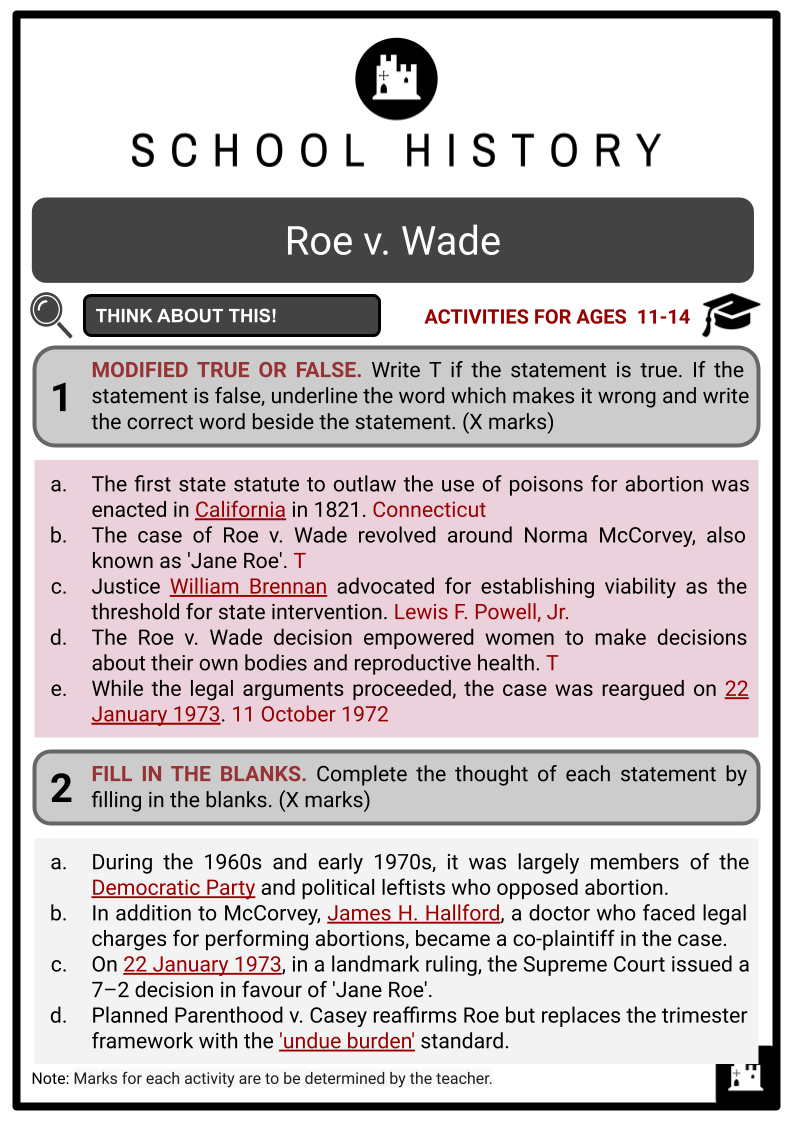
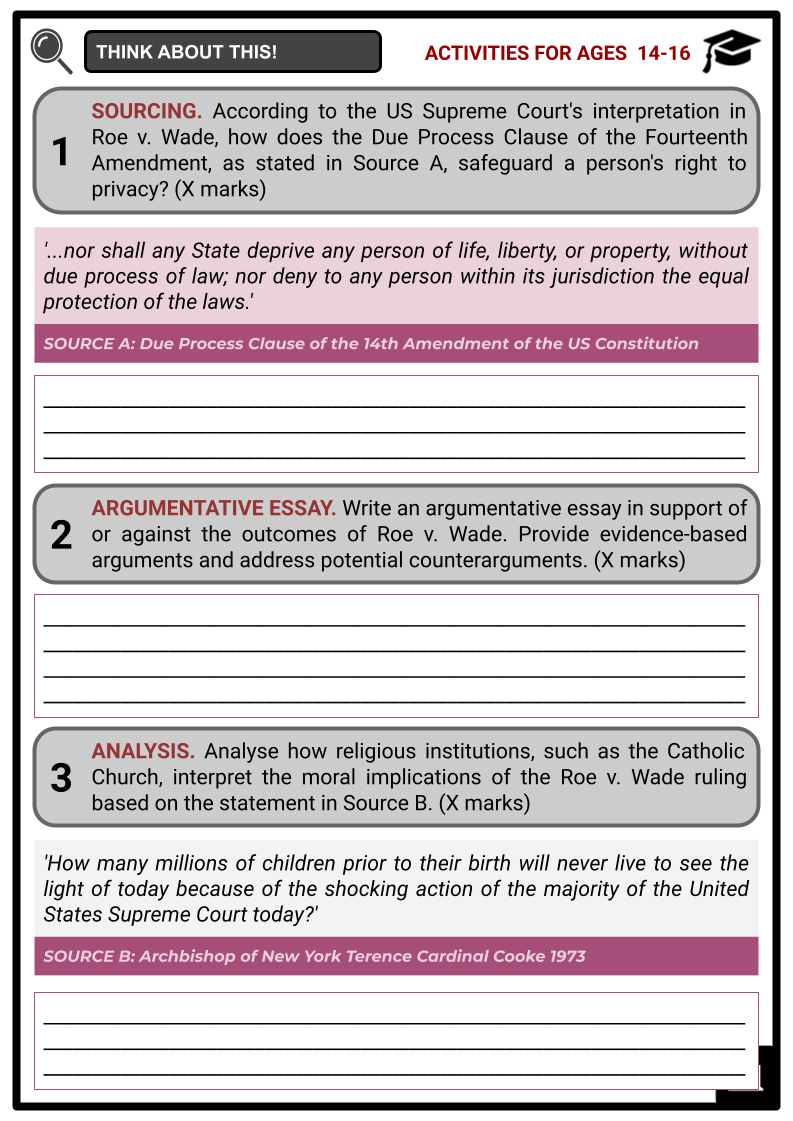
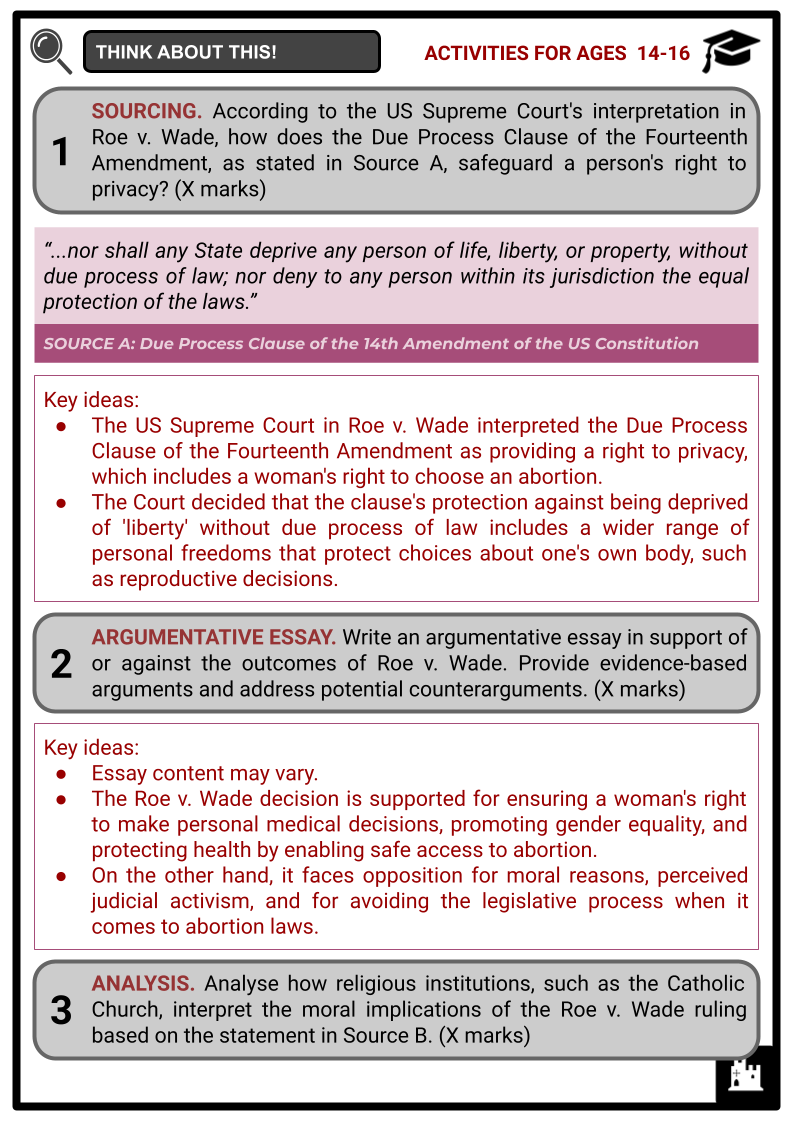
Summary
- Historical Context: Abortion Laws in the US
- The Case of Jane Roe
- Arguments and Legal Framework
- Supreme Court Decision
- Reception
- Socio Political Impact: Women’s Rights
- Subsequent Developments and Current Status
Key Facts And Information
Let’s know more about Roe v. Wade!
Roe v. Wade is a landmark decision by the United States Supreme Court that legalised abortion. 'Jane Roe', a pregnant woman who sought to end her pregnancy, filed the case. The Supreme Court's ruling in 1973 established a woman's legal right to have an abortion under the 14th Amendment to the Constitution. This decision affected reproductive rights and sparked ongoing debates about the balance between individual autonomy and the state's interest in regulating abortion.
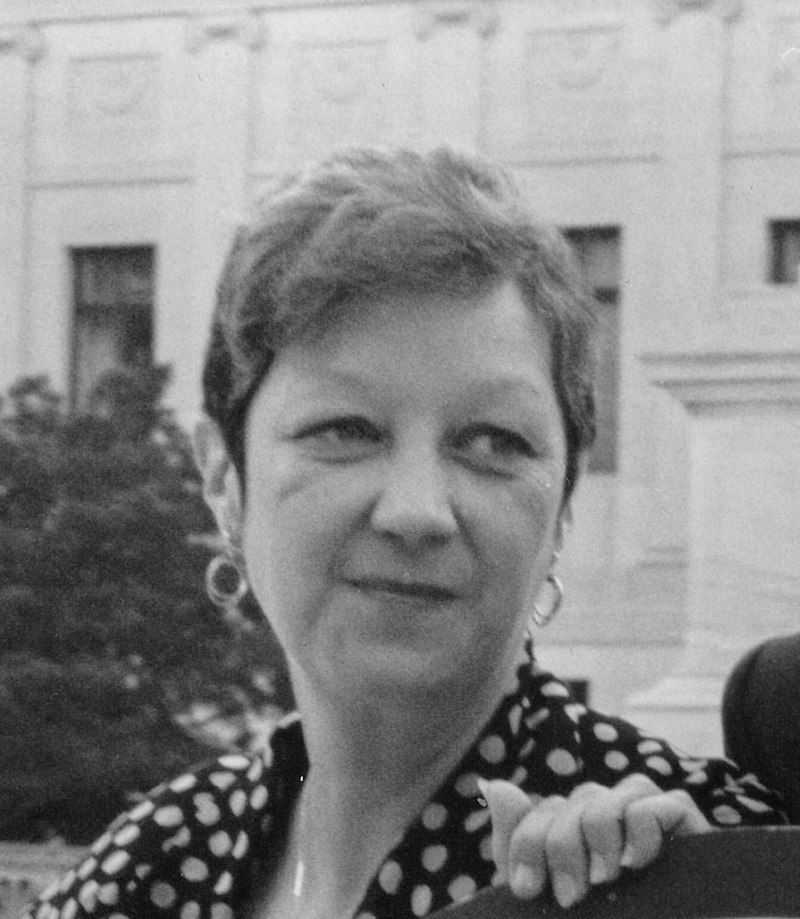
Historical Context: Abortion Laws in the US
- Abortion laws in the United States underwent significant changes from the colonial period to the 20th century, before Roe v. Wade.
- The first state statute to outlaw the use of poisons for abortion was enacted in Connecticut in 1821. Following this, other states began to pass their own laws regarding abortion. The medical community, experiencing internal competition between male degree holders and female practitioners, generally opposed abortion after the 1840s. Media coverage highly influenced the anti-abortion sentiment of the time.
- Initially considered a violation of common law in some instances, abortion before 'quickening' (the first movement of the foetus felt by the pregnant woman, usually between the fourth and sixth months of pregnancy) was largely seen as a morally neutral act.
- However, by the 19th and early 20th centuries, pre-quickening abortions were viewed suspiciously, and if the mother died as a result of the procedure, the person performing the abortion could be charged with murder.
- Justice Harry Blackmun's majority opinion in Roe v. Wade suggested that criminalisation of abortion in the United States had historical roots in English common-law tradition but pointed out that these regulations became more restrictive only after the 1820s. The ruling acknowledged shifts in social attitudes towards abortion, which had been more permissive in earlier times.
- During the 1960s and early 1970s, it was largely members of the Democratic Party and political leftists who opposed abortion. In contrast, the majority of women within the party championed its legalisation. Faith also played an unconventional role in the debate. While most liberal Catholics and Mainline Protestants were opposed to abortion, many other Protestants, including evangelicals, supported abortion legalisation based on principles of limited government involvement, religious freedom and the lack of explicit scriptural condemnation.
The Case of Jane Roe
- The case of Roe v. Wade revolved around Norma McCorvey, also known as 'Jane Roe'. In 1969, at the age of 21, McCorvey became pregnant for the third time after enduring a difficult childhood. While battling drug and alcohol addiction, she faced challenges in her marriage leading to divorce from her spouse. In 1967, she had also given birth to a second child whom she placed for adoption. Despite wanting an abortion, Texas's strict laws made it difficult for her to obtain one.
- After consulting with an adoption solicitor, she was referred to attorneys Linda Coffee and Sarah Weddington. Selecting McCorvey because of her socioeconomic background and race, Weddington and Coffee aimed to challenge Texas's anti-abortion laws that criminalised the procedure except when it posed a risk to the mother's life.
- In addition to McCorvey, James H. Hallford, a doctor who faced legal charges for performing abortions, became a co-plaintiff in the case, bringing a professional perspective to the challenge against the Texas statutes. The defendants were Dallas County District Attorney Henry Wade, representing the state's enforcement of the abortion laws, which were then subject to legal scrutiny for their constitutionality.
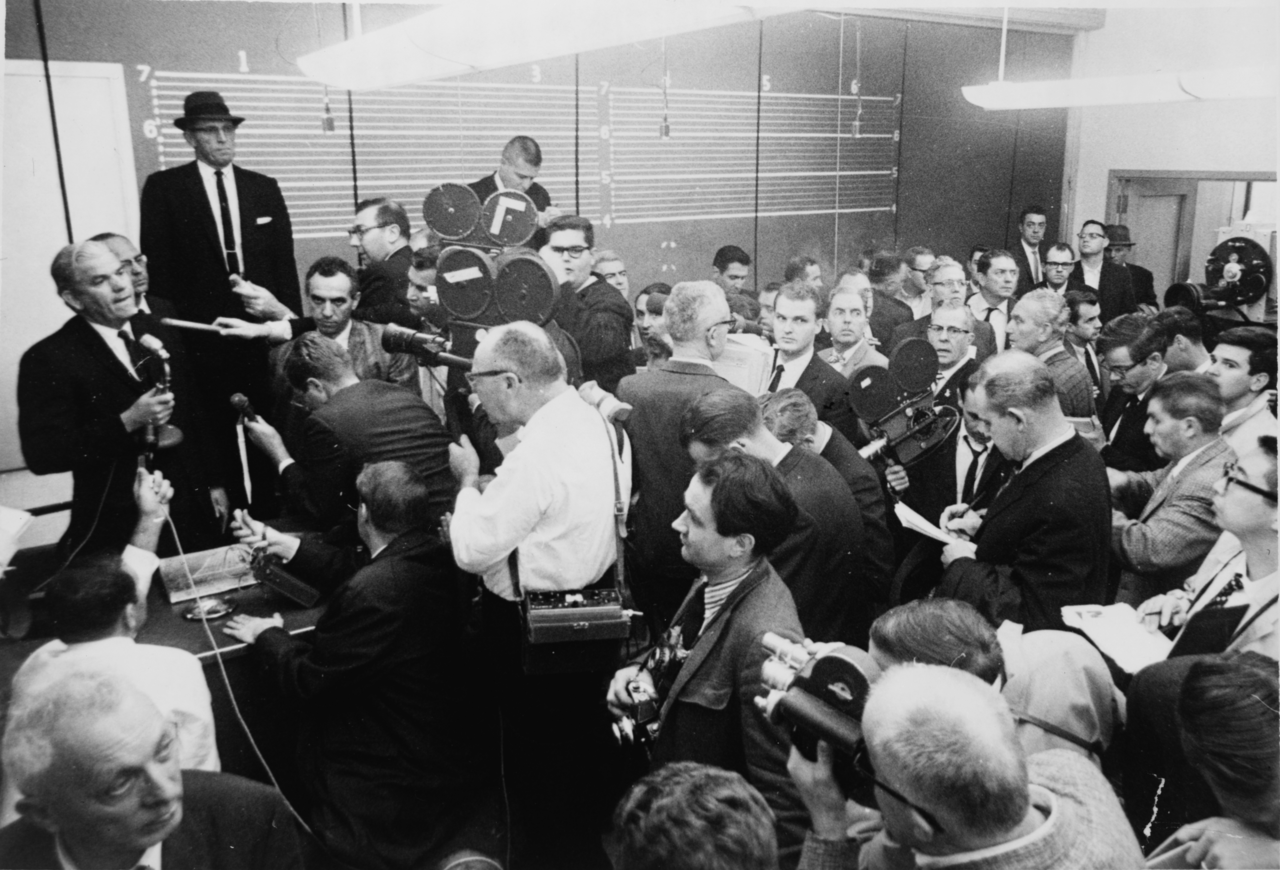
- The case was initially heard by a three-judge panel, which on 17 June 1970, delivered a unanimous decision in favour of McCorvey. The judges determined that the Texas abortion legislation was unconstitutional as it infringed upon the Ninth Amendment's implied right to privacy.
- However, instead of granting an injunction against the Texas statutes, the court dismissed the case, specifying that they lacked standing. As a result, McCorvey had given birth by the time the decision was rendered and did not attain any immediate relief.
- The lack of an injunction meant that the statute continued to be enforceable, allowing Wade to maintain his efforts to prosecute those involved in performing abortions.
- Roe v. Wade was then appealed directly to the United States Supreme Court, where it became one of the most significant cases in US history.
Arguments and Legal Framework
- The legal discussion surrounding Roe v. Wade's case involved various important constitutional issues and sparked debate among legal scholars, both within and outside the judicial setting.
- Justice William O. Douglas drew attention with his dissenting opinion, suggesting that the principles underlying the right to privacy in marital relations, including family planning, should extend to the context of abortion. The Texas abortion statute's ambiguity became a central issue, as highlighted by Justice Harry Blackmun during preliminary deliberations. He argued that this vagueness made the law unconstitutional, avoiding the more complex philosophical debate on when life begins.
- Justice William Brennan, along with Douglas, emphasised the importance of privacy in their considerations. This view aligned with the Supreme Court's decision in Eisenstadt v. Baird, which extended privacy protections related to birth control to unmarried individuals.
- The Supreme Court's internal discussions about framing their ruling were complex. A key point of contention was determining when a state could legally assert an interest in the life of the foetus. Justice Lewis F. Powell, Jr., advocated for establishing viability as the threshold for state intervention.
- The Supreme Court eventually established the trimester framework, with a focus on the significance of the end of the first trimester.
First Trimester:
-
- During the first trimester of pregnancy, the decision to have an abortion is solely at the discretion of the woman.
- The state cannot regulate or prohibit abortions during the initial stage.
- The state's interference is minimal to ensure the safety of the medical procedure.
Second Trimester:
-
- The state may impose regulations on abortion procedures in the interests of the woman's health.
- The state's regulation increases but does not involve outright banning of abortions.
- These regulations must be reasonably related to maternal health only.
Third Trimester:
-
- After the foetus reaches the point of viability (capable of sustained survival outside the womb with or without artificial support), the state may regulate or even prohibit abortions.
- The state's interest expands to potential foetal life.
- Exceptions are made when abortion is necessary to preserve the life or health of the mother.
- While the legal arguments proceeded, the case was reargued on 11 October 1972. Attorney Weddington contended that Texas's abortion laws were unconstitutional, while Robert C. Flowers, who replaced Jay Floyd, defended the state's position. The court faced internal divisions over how to delineate the legal framework.
Supreme Court Decision
- On 22 January 1973, in a landmark ruling, the Supreme Court issued a 7–2 decision in favour of 'Jane Roe', asserting that Texas's abortion ban was unconstitutional. This decision affirmed American women's fundamental right to decide whether to have an abortion and established a legal safeguard against excessive government interference. Importantly, this ruling is closely connected with protections outlined by the 14th Amendment.
Majority Opinion:
- Justice Harry Blackmun: Authored the opinion that a woman has a fundamental right to privacy, which includes the decision to have an abortion. The Court created a framework that considered pregnancy in trimesters, providing stronger protection for a woman's right to an abortion in the earlier stages of pregnancy and allowing states to impose restrictions in the later stages, under specific conditions.
- Justice Potter Stewart: Agreed with Blackmun that the Texas law violated the right to privacy. He concurred on broader constitutional grounds, seeing the decision as an affirmation of individual liberties and the right to make personal decisions without excessive government interference.
- Justice William O. Douglas: Concurred with the majority but expressed that the right to privacy related to abortion could be better grounded in the more expansive Ninth Amendment, which alludes to the existence of rights not specifically mentioned in the Constitution.
Dissenting Opinions:
- Justice Byron White: Argued that the Court's decision represented an overreach of judicial power, believing that the regulation of abortion should be left to the political processes of the states. He viewed the Court's establishment of a new constitutional right to abortion as an unjustified judicial invention.
- Justice William Rehnquist: Criticised the majority for its historical interpretation and its application of substantive due process – an approach historically used to strike down state laws that the Court believed infringed on fundamental rights. He believed that the judicial branch shouldn't have the authority to regulate issues like abortion.
Reception
- The Roe v. Wade decision sparked intense debate, with advocates praising it as a win for reproductive rights and women's autonomy, while opponents viewed it as a threat to life and traditional values, leading to continued efforts to challenge the ruling.
Support for Roe:
- Advocates for women's rights and reproductive freedom hailed the decision as a monumental victory that safeguarded a woman's autonomy over her body.
- The ruling was seen as a step forward for gender equality, with organisations such as Planned Parenthood and the National Organization for Women endorsing the judgement.
- Supporters also argued that the decision protected the health and well-being of women by ensuring access to safe and legal abortion services.
- Legal scholars and some members of the public deemed the decision an appropriate application of the right to privacy.
Opposition for Roe:
- The decision was met with immediate and vehement opposition from anti-abortion and pro-life groups, who viewed it as morally wrong and a form of legalised infanticide.
- Some religious organisations, particularly within the Roman Catholic Church and various evangelical Christian denominations, strongly condemned the ruling, often framing abortion as a religious and ethical issue.
- Several conservative legal scholars criticised the ruling's dependence on the right to privacy, arguing that it was a poor constitutional foundation for abortion rights and an example of judicial activism.
Sociopolitical Impact: Women’s Rights
- The Supreme Court's decision in Roe v. Wade had sociopolitical implications for women's rights, recognising a woman's fundamental right to privacy and the decision to have an abortion. This marked a shift in the legal landscape and had a profound impact on societal attitudes towards women's reproductive autonomy.
- The Roe v. Wade decision empowered women to make decisions about their own bodies and reproductive health. Prior to this ruling, restrictive abortion laws and limited access to reproductive healthcare had posed challenges to women seeking to exercise control over their fertility. The decision in Roe v. Wade validated and affirmed women's agency in matters of reproductive choice, establishing a legal framework that upheld their right to make decisions free from undue government interference.
- The Supreme Court's framework for the trimesters recognised the significance of giving women and their doctors the freedom to make knowledgeable decisions during the early stages of pregnancy. This not only safeguarded women's access to safe and legal abortions but also acknowledged their capacity to make responsible healthcare choices in consultation with medical professionals.
- The sociopolitical impact of Roe v. Wade also extended to broader discussions about gender equality and women's rights. By affirming a woman's right to choose abortion as part of her fundamental right to privacy, the decision challenged societal norms and structures that had traditionally limited women's autonomy and self-determination. It raised critical questions about bodily autonomy, reproductive freedom and gender-based discrimination.
- However, it is essential to acknowledge that the decision in Roe v. Wade also sparked extensive debate and resistance, particularly from those who opposed reproductive rights and sought to restrict women's access to abortion services.
Subsequent Developments and Current Status
- Following the landmark decision in Roe v. Wade, subsequent developments have shaped abortion rights in the United States.
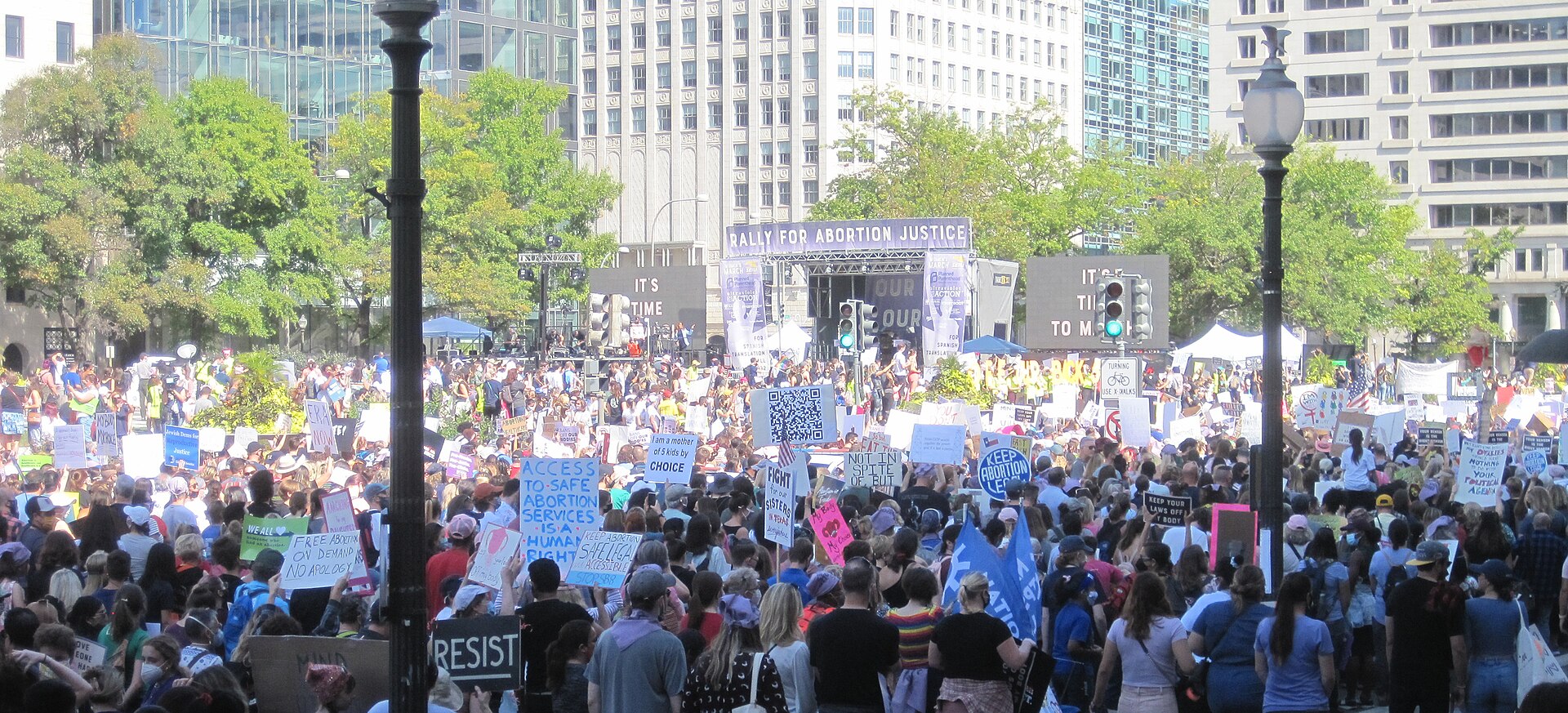
- 1976:
Hyde Amendment is passed, prohibiting federal funds from being used for abortion services except in cases of rape, incest, or when the mother's life is at risk.
- 1980:
Harris v. McRae upholds the Hyde Amendment, ruling that states are not required to fund medically necessary abortions for women on Medicaid.
- 1989:
Webster v. Reproductive Health Services upholds a Missouri law imposing restrictions on the use of state funds, facilities and employees in performing, assisting with or counselling on abortions.
- 1992:
Planned Parenthood v. Casey reaffirms Roe but replaces the trimester framework with the 'undue burden' standard, which prohibits laws that place a substantial obstacle in the path of a woman seeking an abortion before the foetus attains viability.
- 2003:
Partial-Birth Abortion Ban Act is signed into law, banning a procedure known as 'intact dilation and extraction' (sometimes called 'partial-birth abortion').
- 2007:
Gonzales v. Carhart upholds the Partial-Birth Abortion Ban Act, signalling a willingness by the Court to uphold more restrictions on abortion.
- 2016:
Whole Woman's Health v. Hellerstedt strikes down Texas abortion restrictions that required doctors who perform abortions to have admitting privileges at a nearby hospital and forced clinics to meet hospital-like standards for outpatient surgery.
- 2019–2021:
Several states pass highly restrictive abortion laws, often referred to as 'heartbeat bills', which ban abortions after a foetal heartbeat can be detected, as early as six weeks into pregnancy. These laws are intended to challenge Roe v. Wade and are subject to ongoing legal battles.
- The appointment of justices to the Supreme Court has also been a key factor in shaping subsequent developments related to abortion rights. Over the years, the court's composition has shifted, leading to debates about the potential reversal or modification of the principles established in Roe v. Wade.
- This has led to strong opinions and actions from both supporters and opponents of reproductive rights, who closely watch judicial appointments and potential challenges to existing legal precedents.
- In recent years, state legislatures have continued to introduce and enact laws that seek to restrict access to abortion, leading to legal battles and challenges that have brought the issue back into the national spotlight. These developments have heightened public awareness and mobilised advocacy efforts from organisations and individuals seeking to uphold the principles of reproductive autonomy established in Roe v. Wade.
- The current status of abortion rights in the United States remains a subject of intense debate and contention. Ongoing legal battles, legislative initiatives and public discourse continue to shape the trajectory of reproductive rights.
Image Sources
- https://upload.wikimedia.org/wikipedia/commons/thumb/0/04/Norma_McCorvey_%28Jane_Roe%29_onthe_steps_of_the_Supreme_Court%2C_1989_%28cropped%29.jpg/800px-Norma_McCorvey_%28Jane_Roe%29_onthe_steps_of_the_Supreme_Court%2C_1989_%28cropped%29.jpg
- https://upload.wikimedia.org/wikipedia/commons/thumb/2/2a/Henry_Wade_1963_press_conference_NYWTS.png/1280px-Henry_Wade_1963_press_conference_NYWTS.png
- https://upload.wikimedia.org/wikipedia/commons/thumb/4/41/October_2021_Women%27s_March_in_Washington_DC_03.jpg/1920px-October_2021_Women%27s_March_in_Washington_DC_03.jpg
Frequently Asked Questions
- What is Roe v. Wade?
Roe v. Wade is a landmark legal case decided by the United States Supreme Court in 1973. It established a woman's legal right to have an abortion under the Due Process Clause of the 14th Amendment to the United States Constitution.
- What were the critical issues in Roe v. Wade?
The critical issue in Roe v. Wade was whether the state laws banning or restricting abortion were unconstitutional under the right to privacy.
- What was the Supreme Court's decision in Roe v. Wade?
The Supreme Court, in a 7-2 decision, ruled that state laws banning abortion were unconstitutional because they violated a woman's right to privacy in making decisions about her body, including the decision to have an abortion.
